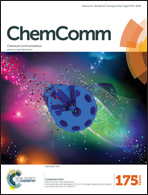Ion transfer battery: storing energy by transferring ions across liquid–liquid interfaces†
Abstract
A battery utilizing the Galvani potential difference between aqueous and organic phases is demonstrated. The battery consists of two organic redox electrolytes separated by an immiscible aqueous phase. The charge is stored by transferring a salt from the aqueous phase into organic phases in ion transfer coupled electron transfer reactions.


 Please wait while we load your content...
Please wait while we load your content...